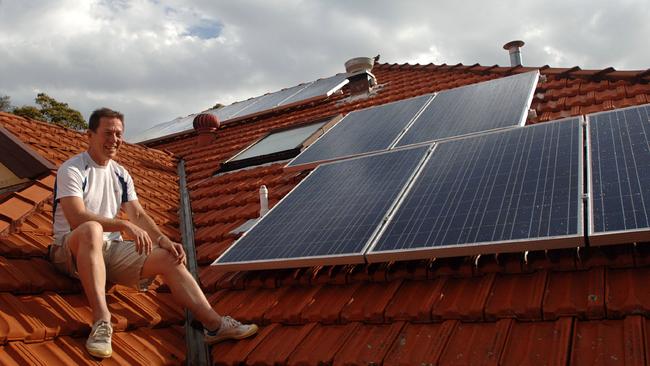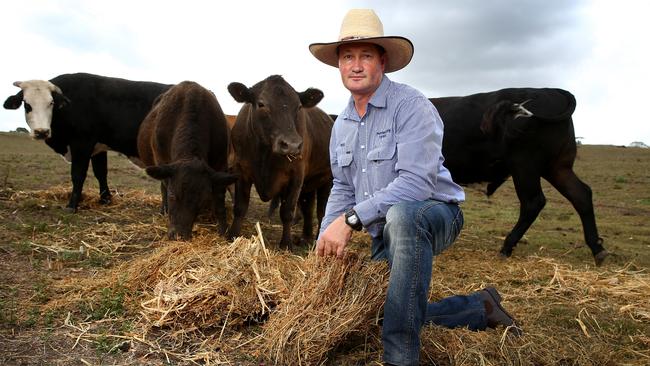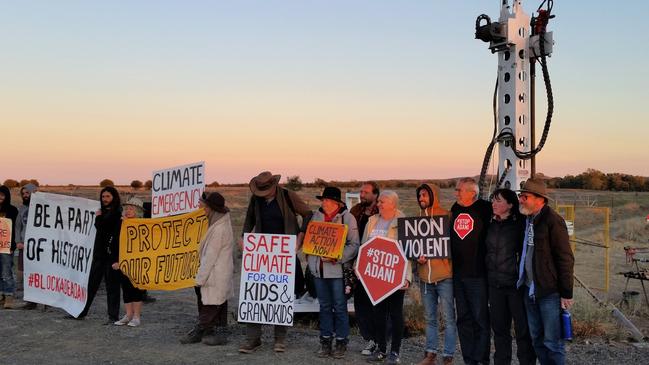Climate change hysteria: Separating myth from fact
Much hysteria surrounds the climate change debate, with activists not letting reality get in the way of a good story. Adella Beaini separates myth from fact.
NSW
Don't miss out on the headlines from NSW. Followed categories will be added to My News.
“How dare you?,” 16-year-old climate activist Greta Thunberg asked of world leaders at the UN Climate Summit this week, accusing them of failing her generation by not acting on climate change.
The Swedish activist’s claims that governments have stolen her hopes and dreams of a happy future were mirrored last week by more than 300,000 protesters who gathered to strike across Australia with similar claims.
Of them, many were children like Thunberg, holding signs making their intentions clear: “No more ScoMo.”


MORE ON THE CLIMATE CHANGE DEBATE
Mental health crisis as kids fear climate change
Striking for climate change doesn’t make you smart
The sentiment was “we are all doomed’’, “the government is doing nothing”, “sea levels are rising all the time” and “the Adani mine is evil”.
But experts say while their fears have some grounding, it’s not all doom and gloom for today’s youth.
Here we look at the facts rather than the fiction and find that the Federal Government is actually doing something and that the Adani mine won’t make a bit of difference either way.
“This generation faces the worst future because of climate change”: But it’s not all doom and gloom.
The health of a typical Australian has improved so much over the past century. Back in 1919, 11,833 children didn’t live to see their fifth birthday, and 570 women died during childbirth.
Fast forward about 100 years, the toll has been significantly reduced.
Australian Institute of Health and Welfare (AIHW) data shows a total of 1209 children under the age of five died in 2017, and that year five women died during childbirth.
Back in 1919, the life expectancy at birth for an Australian was 59.2 years for a baby boy and 63.3 years for a baby girl.
In Australia, a boy born in 2015–2017 can expect to live to the age of 80.5 years and a girl would be expected to live to 84.6 years compared to 47.2 and 50.8 years, respectively, in 1881–1890.

Men aged 65 in 2015–2017 could expect to live another 19.7 years and women aged 65 in 2015–2017 could expect to live another 22.3 years.
According to the AIHW, provided current living standards are maintained, a baby girl born this year will likely live to see the dawn of the 22nd century.
But these improvements in life expectancy and reductions in maternal and infant deaths are not restricted to wealthy countries such as Australia.
In a 2018 TED Talk by Harvard University psychology professor Steven Pinker, he said that people worldwide are doing better now compared with 30 years ago.
MIRANDA DEVINE: Charges should be laid over the abuse of Greta Thunberg
TIM BLAIR: Heroes to zeroes in just one century
ALAN JONES:Climate strike children should get off their electronic devices
“Last year (2017), the world had 12 ongoing wars, 60 autocracies, 10 per cent of the world population in extreme poverty and more than 10,000 nuclear weapons,” he said.
“But 30 years ago, there were 23 wars, 85 autocracies, 37 per cent of the world population in extreme poverty and more than 60,000 nuclear weapons.”
And while Professor Pinker acknowledges that we should look at things like climate change and nuclear war as problems to be solved, not apocalypses in waiting, he said people don’t tend to appreciate this progress.
“The papers could have run the headline ‘137,000 people escaped from extreme poverty yesterday’ every day for the last 25 years,” he said. “That’s one and a quarter billion people leaving poverty behind, but you never read about it.”

A rapidly changing sea-nery
The future of low-lying Pacific nations is a key focus for the Intergovernmental Panel on Climate Change (IPCC), with a report released on Wednesday outlining the latest science on sea level rises, ice melt and the potential impact on extreme weather events and coastal areas.
On sea levels, the best case was for a rise of between 30cm and 60cm by 2100 if greenhouse gas emissions were sharply reduced and global warming limited to less than 2C.
The IPCC report said the rate of sea level rise has accelerated in recent decades due to melting ice sheets in Greenland and Antarctica as well as meltwater from glaciers and the expansion of warmer sea waters.
Addressing the United Nations General Assembly earlier this week, Scott Morrison said that the government would lead an “urgent action to combat plastic pollution choking the oceans”.
“Scientists estimate that in just 30 years’ time the weight of plastics in our oceans will exceed the weight of fish,” Mr Morrison said.
In August, the government announced it will do more to tackle plastic waste in the world’s oceans, saying the export of waste plastic, paper, glass and tyres will be banned by 2020.
Australia is also investing $167 million in an Australian Recycling Investment Plan, focusing on “creating the right investment environment so that new technologies are commercialised — preventing pollution entering our oceans, and creating valuable new products”.
Mr Morrison also confirmed to the UN that Australia wouldn’t contribute anymore to the global Green Climate Fund.
Instead, Australia would be redirecting $500 million of its aid money to help Pacific Island nations become more resilient in the face of the effects of climate change.

“We demand 100 per cent renewable energy generation and exports by 2030” — how realistic is that?
In Australia, renewable energy is growing at a per capita rate 10 times faster than the world average. Between 2018 and 2020, Australia will install more than 16 gigawatts of wind and solar, an average rate of 220 watts per person per year.
This is nearly three times faster than the next fastest country, Germany. Australia is demonstrating to the world how rapidly an industrialised country with a fossil-fuel-dominated electricity system can transition towards low-carbon, renewable power generation.
In 2017, the investment in renewables in Australia increased by 150 per cent, reaching record levels. Australia also invested $11 billion investment in 2018 to clean energy, placing the country seventh in the world — third on a per capita basis.
Last year was also the biggest ever year for rooftop solar installation. One in five Australians now has solar panels on their roof – one of the highest rates in the world.
Australia is on track to achieve 50 per cent renewable electricity by 2030 even without new federal energy policies, according to modelling by the energy analysts RepuTex.
It’s expected renewable energy will reach 23.5 per cent of Australia’s electricity supply by 2020.
Unprecedented investment in large wind and solar power projects has put Australia on track to meet the federal government’s 2020 large-scale renewable energy target.
The government had previously indicated that 6400 megawatts of large-scale renewable capacity had to be built between 2017 and 2019 to generate sufficient electricity to meet the target of having 33,000 gigawatt hours of additional energy by next year.
State government programs are also supporting renewable electricity growth. The ACT has completed contracts for 100 per cent renewable electricity. Victoria and Queensland both have renewable energy targets of 50 per cent renewable electricity by 2030. South Australia is expecting to reach 100 per cent by 2025.

In the climate wars, farmers are the forgotten key to reducing emissions
In February this year, the government established a Climate Solutions Fund to provide an additional $2 billion to continue purchasing low-cost abatement, built on the success of the Emissions Reduction Fund to reach Australia’s 2030 emissions reduction target.
About $2.55 billion was invested in the Emissions Reduction Fund in 2014, which has delivered 193 million tonnes of emissions reductions and boosted help for farmers, small businesses and Inidigenous communities.
Carbon Farmers of Australia director, Louisa Kiely, has been helping Australian farmers for more than a decade to transform farms from sources of carbon to carbon sinks.
“We use farming methods that reduce greenhouse gas emissions or capture and hold carbon in vegetation and soils,” Ms Kiely said.
“Not only does it reduce the levels of CO2-e being released into the atmosphere, but they can lead to an improvement in farm efficiencies and profitability.”
Ms Kiely said “farmers of the world” will not only improve the productivity but also mitigate the effects and actually take the carbon out of the air.
“You can demand 100 per cent renewable energy and turn off every light in the universe and you won’t stop the world from going through the two or three degree increase because of what’s already up in the air,” she said.
“Yes we need renewable energy which prevent carbon in the air, but the stuff driving the rising temperatures is what’s already in the air and can be taken out by farmers and buy some time.”
World leading soil scientist Dr Rattan Lal believes the world’s farmers control the largest installation of a biological technology that can extract billions of tonnes of carbon from the atmosphere, interrupting the rapid rise of Global Warming.
James Chin Moody, who worked for the United Nations, the CSIRO and the Australian Bureau of Statistics, said: “The best thing about carbon farming is that it is one of those “win-win-win”s.”
“Not only are you trapping carbon, but you are improving the soil, enhancing food security and promoting rural economies.”
Mr Morrison said Australia’s emissions per capita was at a 29-year low, with the highest investment in renewables per capita of any country.

What’s the deal with Adani?
The global greenhouse gas emissions will be largely unchanged whether Adani proceeds or doesn’t, with the world consuming around 5.5 trillion tonnes of coal each year to burn in power stations and make electricity.
In developed economies coal use is declining, while the World Bank funds coal-fired power stations in a number of developing countries. It’s likely the last users of coal will be the world’s poorer nations.
And if the proposed Adani mine proceeds, it would produce around 27 million tonnes a year at capacity. Not even half of 1 per cent of global demand.
Experts advice the focus on reducing emissions should not be on banning a coal mines, but instead providing a credible and affordable way of making electricity that can replace coal.
But sustainability expert and researcher from the University of Queensland Business School, Dr Cle-Anne Gabrie, said the demand is achievable and “already underway”.
“It makes economic sense. For instance, insurance companies will no longer insure new coal mines and power plants, and that is a huge step in the right direction,” Dr Gabrie said.
“Already, there are now no Australian insurers remaining who will “invest in, finance and insure new thermal coal mines and power plants.”
